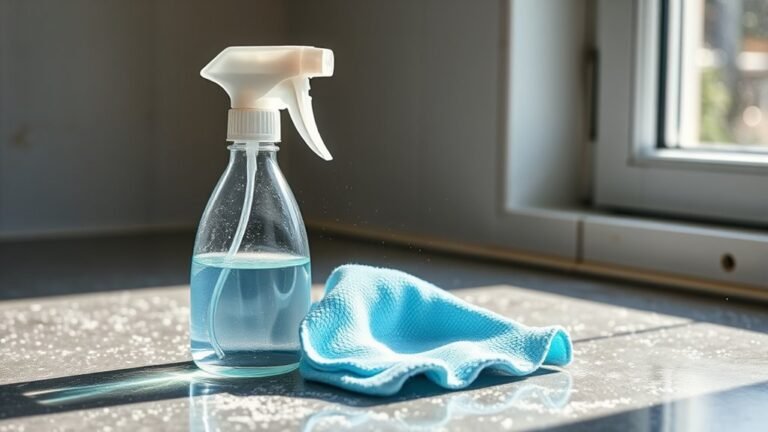Spring Cleaning Guide for Grout
When you tackle grout this spring, start by knowing your grout type to choose the right cleaner. Gather tools like a grout brush, gloves, and a gentle cleaner—baking soda and vinegar work great naturally. Sweep first, apply the solution, let it sit, then scrub and rinse well. Don’t forget to seal grout afterward to prevent stains and mold. Keep going to find easy methods and tips for lasting grout protection.
Understanding Different Types of Grout

Grout comes in various types, each designed for specific uses and materials. When you’re ready to tackle your grout cleaning, understanding these types will set you free from guesswork. Cementitious grout, the classic choice, is made from a mix of cement, water, and sand. It’s affordable and easy to work with but can stain or crack if not sealed properly. On the other hand, epoxy grout offers superior durability and resistance to stains, making it perfect for areas exposed to moisture or heavy use. It’s chemical-resistant and harder to damage, giving you peace of mind. Knowing whether you’re dealing with epoxy grout or cementitious grout can help you choose the best cleaning approach, so your grout stays fresh without limits.
Tools and Materials Needed for Grout Cleaning
Before you plunge into cleaning, you’ll want to gather the right tools and materials to make the job easier and more effective. Start with quality grout brushes—these are designed to reach into narrow grout lines and scrub away dirt without damaging tiles. Next, choose your cleaning solutions wisely. Opt for products that are effective yet gentle enough to protect your grout’s integrity. You can find specialized grout cleaners or make your own with natural ingredients like baking soda and vinegar for a more eco-friendly approach. Don’t forget essentials like gloves to protect your hands and a spray bottle for easy application. Having these tools and materials ready gives you the freedom to tackle grout cleaning confidently and efficiently, turning a chore into a straightforward task.
Step-by-Step Grout Cleaning Methods

Cleaning grout effectively involves a few straightforward steps that anyone can follow. First, sweep or vacuum the area to remove loose dirt. Next, apply your chosen grout cleaner evenly and let it sit for a few minutes to loosen grime. Use a stiff brush to scrub the grout lines, focusing on stained spots. After scrubbing, rinse thoroughly with warm water and dry the surface. Once your grout is clean and dry, consider grout sealing to protect it from future stains and moisture. If you want to refresh your space, explore color matching grout options to complement your tiles perfectly. Following these steps gives you freedom from stubborn dirt and keeps your grout looking fresh and vibrant, making your spring cleaning both effective and rewarding.
Natural and Homemade Grout Cleaning Solutions
If you prefer a more natural approach, there are plenty of homemade solutions you can try to tackle grout stains without harsh chemicals. Here are three effective methods to reclaim your grout’s brightness:
- Mix baking soda with water to create a paste, apply it to grout lines, let it sit for 10 minutes, then scrub with a toothbrush.
- Use a vinegar solution—combine equal parts white vinegar and water in a spray bottle. Spray it on grout, wait 5 minutes, then wipe clean.
- Combine baking soda and the vinegar solution for a fizzy reaction; apply this to stubborn stains, scrub gently, and rinse thoroughly.
These options let you clean freely and safely, avoiding toxins while restoring your grout’s fresh look.
Preventing Grout Stains and Mold Growth

Though grout can brighten your space, it’s prone to stains and mold if not properly cared for. To keep your grout looking fresh, you’ll want to invest time in preventative maintenance. Regularly wiping down grout lines and ensuring proper ventilation reduces moisture buildup, which molds love. Applying grout sealant options is a game-changer; these sealants create a protective barrier that repels water and stains, making cleaning easier and extending grout life. You can choose from penetrating sealants or surface sealants depending on your grout type and location. By committing to these simple steps, you’re freeing yourself from constant scrubbing and preserving the beauty of your floors and walls. Prevention truly beats cure, and with a little effort, your grout will stay spotless and mold-free.
When to Call a Professional for Grout Restoration
While regular upkeep can solve many grout issues, there are times when you’ll need professional help to restore it properly. Knowing when to call in professional services can save you time and guarantee lasting results. Consider reaching out for help if:
- Your grout is severely cracked or crumbling, making DIY fixes ineffective.
- Persistent stains and mold keep coming back despite thorough cleaning.
- You want to refresh large areas quickly without risking damage or uneven results.
Professional services have the tools and expertise to tackle tough grout problems, restoring its appearance and durability. Don’t hesitate to seek their help if your grout needs more than routine cleaning — it’s about preserving the freedom to enjoy your space without constant worry.
Frequently Asked Questions
Can Grout Color Be Changed After Cleaning?
Yes, you can change grout color after cleaning by exploring grout staining options. Once your grout is clean and dry, you’re free to apply grout dye, which offers a fresh, bold look or a subtle shift in tone. Grout dye application is straightforward, letting you customize your space without replacing tiles. This way, you’re not stuck with the original color and can express your personal style easily.
How Long Does Grout Sealing Last?
You might think grout sealing is a one-and-done deal, but it actually lasts about 1 to 3 years depending on wear. To keep your grout looking fresh, following grout longevity tips like regular cleaning and avoiding harsh chemicals helps. Don’t worry about sealing frequency too much—you can check annually and reseal when water stops beading. This way, you stay in control, enjoying your space without grout worries holding you back.
Is Grout Safe for Pets and Children?
You’ll be glad to know grout itself is generally safe for pets and kids once it’s fully cured. For pet safety and child safety, it’s important to avoid harsh chemicals during cleaning, as they can be toxic. Opt for non-toxic, natural cleaners to keep your home safe and free. Always let grout sealers dry completely before letting pets or children roam freely to guarantee their health isn’t compromised.
Can Grout Damage Hardwood Floors?
You don’t have to worry about grout directly damaging your hardwood floors, but grout maintenance tips are key to avoiding any mishaps. If grout or grout cleaner seeps onto your hardwood, it could cause stains or damage if left too long. To keep your hardwood floor protection strong, always seal grout lines properly and clean spills immediately. That way, you get freedom to enjoy both surfaces without stress.
What Causes Grout to Crack or Crumble?
You’ll find that grout cracks or crumbles mainly because of poor grout maintenance tips like neglecting sealing or exposure to harsh moisture. Common grout issues often stem from improper installation, heavy foot traffic, or shifting floors, causing the grout to weaken. To keep your grout strong and lasting, you’ll want to regularly clean, seal it properly, and avoid harsh chemicals, giving you the freedom to enjoy your space without constant repairs.






